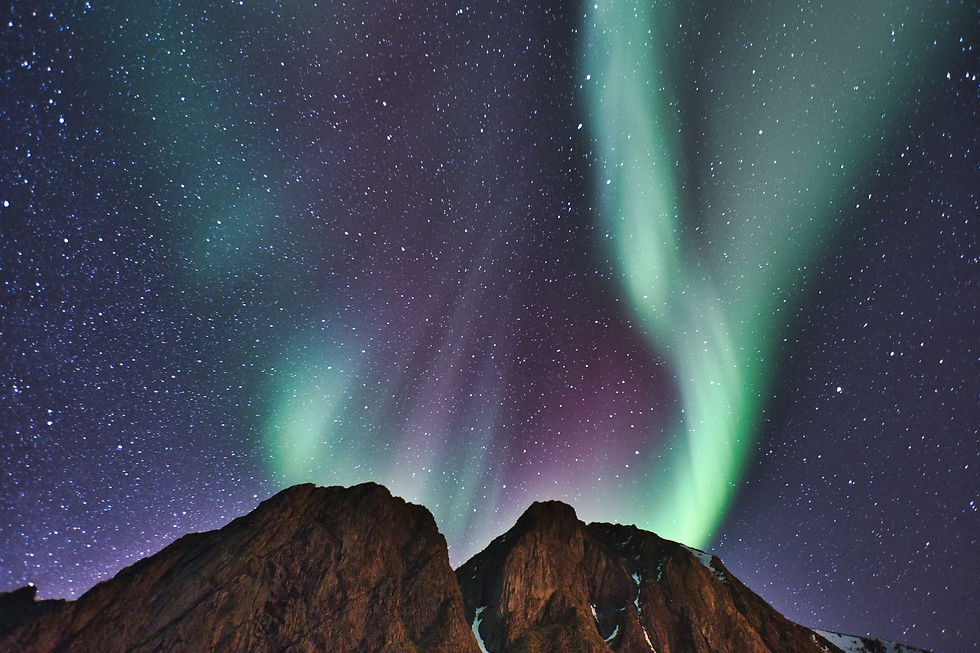Auroras, also known as the Northern and Southern Lights, are among the most mesmerizing and mysterious natural phenomena on Earth. These celestial displays of light have captivated humans for centuries, evoking wonder and awe. Join me as we delve into the enchanting world of auroras, exploring their origins, colors, and where to witness these breathtaking spectacles.

What are Auroras?
Auroras are luminous displays that occur in the Earth’s polar regions, primarily near the Arctic and Antarctic circles. They are caused by the interaction of charged particles from the Sun with the Earth’s magnetic field. Solar wind, composed of charged particles such as electrons and protons, collides with atoms and molecules in the Earth's atmosphere, causing them to emit light.
The Science Behind Auroras
When charged particles from the Sun enter the Earth’s magnetosphere, they follow the lines of magnetic force and collide with atoms and molecules in the atmosphere, primarily oxygen and nitrogen. These collisions excite the atoms, causing them to emit light at different wavelengths, producing the vibrant colors of the auroras.
Colors of Auroras:
Green: The most common color, produced by oxygen atoms at lower altitudes (about 60 miles above the Earth’s surface).
Red: Occurs at higher altitudes (over 150 miles), also from oxygen atoms, but it requires more energy.
Blue and Purple: Rare colors caused by nitrogen molecules.
Yellow and Pink: Occasionally seen during intense solar activity.
Where and When to See Auroras
The best places to see auroras are near the magnetic poles:
Northern Hemisphere: Northern Canada (Yukon, Northwest Territories), Alaska, Iceland, Norway (Tromsø, Lofoten Islands), Sweden, and Finland.
Southern Hemisphere: Southern Argentina (Patagonia), Southern Australia (Tasmania), New Zealand (South Island), and Antarctica.

Tips for Viewing Auroras
Time of Year: Auroras are visible year-round, but they are more frequent and intense around the equinoxes (March and September) due to increased solar activity.
Weather Conditions: Clear, dark skies away from city lights provide the best viewing conditions.
Camera Settings: Capture the auroras with a DSLR camera on a tripod, using long exposures (10-30 seconds) and a high ISO (800-1600) to capture the faint light.
Cultural and Mythological Significance
Throughout history, auroras have inspired awe and wonder, leading to various cultural interpretations and myths:
Inuit: Believed the auroras were spirits playing ball with a walrus skull.
Norse Mythology: Viewed the auroras as reflections of the armor of the Valkyries.
Chinese: Thought the auroras were dragons fighting in the sky.
Conservation and Preservation
As we marvel at the beauty of auroras, it’s essential to consider their conservation:
Dark Sky Parks: Visit designated dark sky parks to reduce light pollution and preserve the natural beauty of the night sky.
Climate Change: Monitor how auroras may be affected by climate change and advocate for measures to mitigate its impact.

Auroras are a testament to the Earth’s connection with the cosmos, a reminder of the dynamic forces at play in our solar system. Whether you witness the shimmering curtains of green in the Arctic or the dancing ribbons of color in the Antarctic, experiencing auroras is a moment of profound wonder and connection with nature. As we continue to study and appreciate these celestial wonders, let us also strive to protect and preserve the conditions that allow them to illuminate our skies.
Have you been fortunate enough to witness the Northern or Southern Lights? Share your experiences and thoughts on these captivating displays of nature in the comments below!
Comments